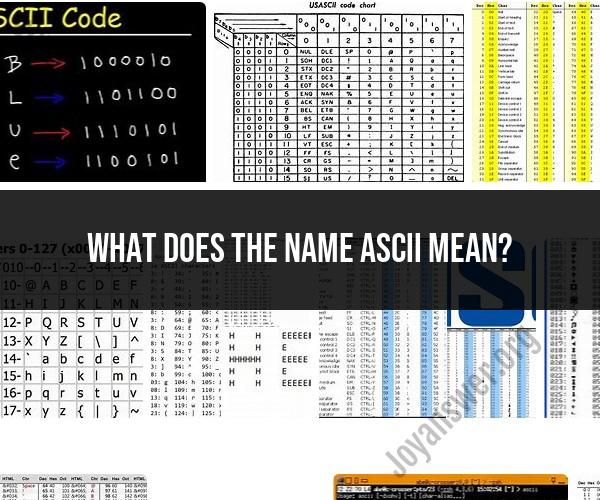What does the name ASCII mean?
The name "ASCII" stands for "American Standard Code for Information Interchange." It is a character encoding standard used in computing and telecommunications to represent text and control characters as binary values (0s and 1s) that can be easily interpreted and exchanged between different computer systems and devices. ASCII was first developed in the early 1960s and has since become a fundamental component of computer communication and data storage.
Here's a brief historical overview of ASCII:
Development and Standardization: ASCII was developed by a committee of the American National Standards Institute (ANSI) in the early 1960s. The primary goal was to create a standardized character encoding scheme that could be universally adopted for computers and communication equipment in the United States. The first version of ASCII, known as ASCII-1963, was published in 1963.
Character Set: The ASCII standard defines a set of 128 characters, including control characters (such as line feed and carriage return) and printable characters (letters, numbers, punctuation marks, and symbols). The encoding assigns a unique 7-bit binary code (from 0000000 to 1111111) to each character.
International Adoption: While ASCII was initially developed for American use, its simplicity and compatibility led to widespread international adoption. Many early computers and computer systems around the world used ASCII encoding for text representation.
Extended ASCII: To accommodate additional characters and symbols required for various languages and applications, several extended versions of ASCII were developed. These extended versions used the eighth bit (bit 7) to represent additional characters, resulting in 8-bit character encodings. Examples include ISO 8859 and Windows-1252, which are extensions of ASCII for various language subsets.
Unicode: As computing became more global and diverse, it became apparent that ASCII and its extended versions were insufficient to represent the characters of all languages and scripts. Unicode, introduced in the late 1980s, was developed as a more comprehensive character encoding standard that supports characters from virtually all world scripts, mathematical symbols, emojis, and more. Unicode has largely replaced ASCII for multilingual text representation.
While ASCII has been largely superseded by Unicode for multilingual text, it still plays a vital role in many computing contexts, especially for basic text processing, control characters, and legacy systems. The name "ASCII" itself reflects its American origins, as it was developed as a national standard, but its significance and use extend far beyond the United States.
ASCII Explained: The Meaning Behind the Name
ASCII stands for American Standard Code for Information Interchange. It is a character encoding standard that assigns a unique 7-bit code to each letter, number, and symbol. ASCII was first developed in the 1960s and has since become the standard character encoding for most computer systems and communications networks.
Deciphering ASCII: Origins and Significance
ASCII was developed in response to the need for a standard way to represent text on computers and communications networks. Prior to ASCII, there were many different character encodings in use, which made it difficult for computers from different manufacturers to communicate with each other.
ASCII was developed by a committee of experts from the American National Standards Institute (ANSI) and the American Telephone and Telegraph Company (AT&T). The first version of ASCII was published in 1963 and included 128 characters. The standard was updated in 1967 to include 32 additional characters, including control codes.
ASCII has been essential to the development of modern computing. It has allowed computers from different manufacturers to communicate with each other and has made it possible to develop standard applications such as email, web pages, and programming languages.
The Language of Computers: Delving into ASCII
ASCII characters are represented by 7-bit binary numbers. This means that each ASCII character can be stored in a single byte of memory. ASCII characters are divided into two categories: printable characters and control characters.
Printable characters are the characters that are displayed on the screen when you type them. Printable characters include letters, numbers, symbols, and punctuation marks.
Control characters are special characters that are used to control the behavior of devices such as printers and keyboards. Control characters are not displayed on the screen when you type them.
ASCII is a simple and efficient character encoding standard. It is supported by virtually all computer systems and communications networks. ASCII is essential to the development of modern computing and is likely to remain relevant for many years to come.
Here are some additional facts about ASCII:
- ASCII is the basis for other character encodings, such as Unicode.
- ASCII is used in a variety of applications, including email, web pages, programming languages, and data files.
- ASCII is the most widely supported character encoding, which makes it ideal for communicating and exchanging data between different computer systems.
ASCII is a fundamental part of computing and is essential for understanding how computers work.


